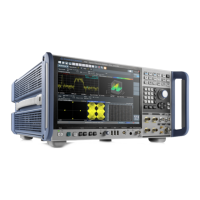Common Measurement Settings
R&S
®
FSW
404User Manual 1173.9411.02 ─ 43
8.2.4.5 Measurement Example: Calibration with an External Generator
The following measurement example demonstrates the most common functions using
an external generator. This example requires the External Generator Control option.
The example assumes an SMW100A generator is connected to the R&S FSW. A band
elimination filter is the device under test. After calibration, an additional attenuator is
inserted between the DUT and the R&S FSW.
The following procedures are described:
●
"Calibrating the measurement setup" on page 404
●
"Measuring the effects of the DUT" on page 405
●
"Compensating the effects of additional attenuation after calibration" on page 407
Calibrating the measurement setup
1. Connect the signal generator's GPIB interface connector to the [Ext. Gen.Control
GPIB] connector on the rear panel of the R&S FSW.
2. Connect the signal generator output to the [RF input] connector of the R&S FSW.
3. Adapt the measurement range of the R&S FSW to the filter to be tested. In this
measurement, define the following settings:
a) Press the [FREQ] key, select "Frequency Config" and enter "Frequency Start":
100
MHz.
b) Enter "Frequency Stop": 300
MHz
4. Press the [INPUT/OUTPUT] key and select "External Generator Config".
5. In the "Interface Configuration" sub-tab, select "Generator Type":"SMW06".
6. Select "Reference: External" to synchronize the analyzer with the generator.
7. Switch to the "Measurement Configuration" sub-tab.
8. Set the "Source State" to "On".
9. Define the generator output level as the "Source Power": -20
dBm.
10. Set the "Coupling State" to "Auto".
The "Result Frequency Start" value for the generator is indicated as 100.0
MHz.
The "Result Frequency Stop" value is indicated as 300.0
MHz.
11. Switch to the "Source Calibration" sub-tab.
12. Select the "Source Calibration Type": "Transmission" to perform a calibration
sweep and store a reference trace for the measurement setup.
Data Input and Output

